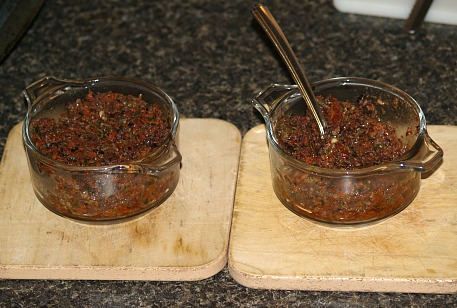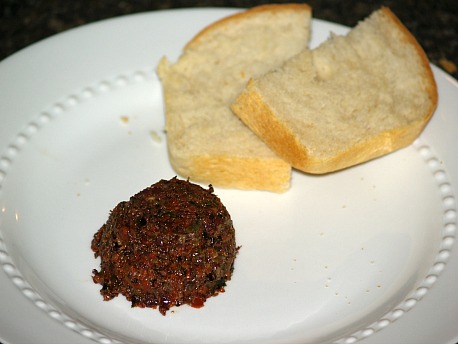- Painless Cooking
- Appetizers
- Olive
How to Make Olive Appetizer Recipes
Learn how to make Olive appetizer recipes which are always a welcome sight at any party, social gathering or for simple snacks. This fruit is native to the regions of the Eastern Mediterranean. We can find this famous tree mentioned in the Bible and many other ancient works of literature.
Olive oil has long been considered sacred and is still known as one of the most important oils for cooking and for its many health benefits. Aside from the oil, the olives serve an important role in various recipes made around the world.
When you learn how to cook with olives you will learn there are basically two types of olives; the green ones and black ones. Green olives are picked and processed before they ripen. Black olives are ripened and less bitter than the green ones of the same variety; they lose the bitterness as they ripen.
There are many variations from these two types to use in olive appetizer recipes. Most simply are described by the country in which they are grown. The Mediterranean are is the oldest and most famous for growing olives so many are known as being Greek olives or Italian olives. The abundance which are produced here makes it reasonable why they are included in the cuisine; especially the delicious Italian appetizers. Here in the United States, California is also known to grown delicious olives.
When you learn how to cook using olives you may want to keep different types in your pantry. I almost always keep several types of olives in stock to fill the various needs for my olive appetizer recipes. You may also and not realize it because once canned, they often appear alike. Many companies place their label on the can or jar and never mention the exact name of the olives.
If you are truly an “olive connoisseur”, you will be able to describe the intricate taste of the different types of olives; nutty, fruity and the various texture qualities. I am not that specialized; I only know what taste I am trying to get by using them in my olive appetizer recipes; some being more salty than others and some having a crisper texture than others. The following are a few which I can identify.
I often use MANZILLA OLIVES in many salad recipes, in olive appetizer recipes or they can be added to martinis. These are native of Spain but are commonly available in the grocery stores. They are small green olives and can be purchased pitted, stuffed with pimiento or stuffed with other things like garlic.
PICHOLINE OLIVES seem to be a little larger green olive and make a pretty presentation when serving as a snack or with an alcoholic beverage. This French olive is known as the “cocktail” olive. The ones I have purchased have had the pits still in them. They are described as chewy and creamy with a nutty flavor these are great in olive appetizer recipes.
Quite often I will use KALAMATA OLIVES. They are described as having a rich flavor and I do agree, they add richness to recipes like the tapenade below. This is a deep purple black ripe Greek olive.
NICOISE OLIVE is small fully ripe olive when harvested. It is the choice of olives for the cuisine of Southern France with a rich nutty flavor.
GAETA OLIVE is left to ripen fully on the tree giving it a rich bold flavor. It is dry salt cured and then rubbed with oil. It is used in many slow cooked stews.
HOW TO MAKE A TAPENADE RECIPE WITH OLIVES
Tapenade is a well seasoned olive based spread. Before the French name “tapenade” came about, this type of recipe is documented to ancient Roman times. It is so delicious when served with slices of homemade bread.
Although the basis of the tapenade recipe is the olives, many other ingredients give it a wonderful blend of flavors. Anchovies are a must for this recipe, as well as the garlic. Some recipes do not have sun dried tomatoes in them, but they really do add a lot of flavor. Due to the salt in the olives, capers and anchovies, do not add any extra. The following is my recipe and it is very flavorful.
- 1 Jar (7 ounces) pitted kalamata olives drained
- 1 Can (6 ounces) pitted black olives (drained)
- 1 Jar (5 ounces) sun dried tomatoes in olive oil (Save oil)
- 1 Jar (3 ½ ounces) balsamic capers
- 1 Can (2 ounces) anchovy fillets
- 4 Cloves garlic
- ¼ Cup chopped fresh parsley
- ¼ Cup chopped fresh basil
Grind all ingredients with a fine blade or process all in blender.
Drain excess liquid (If there is any) off through a strainer until mixture is dry.
Add about 2 tablespoons of saved olive oil from tomatoes; stir until spreadable.
Serve with small pieces of fresh homemade bread or crackers.
OLIVE APPETIZER RECIPE IN SPICY MARINADE
This recipe is “mucho caliente” with all the flavors and spice of Mexico.
- 2 Jars (3 ounces each) pimiento stuffed olives drained
- 2 Jars (3 ounces each) almond stuffed olives drained
- 4 Cloves minced garlic
- 2 Tablespoons dried crushed red pepper
- 2 Teaspoons dried cumin
- ½ Cup water
- 1 Tablespoon olive oil
- 3 Tablespoons chopped fresh cilantro
Combine all ingredients except the chopped fresh cilantro in a medium saucepan.
Bring the mixture to a boil over medium heat; reduce heat and simmer minutes.
Remove the mixture from the heat and cool; stir in chopped fresh cilantro.
Cover and chill at least 8 hours or up to a week.
MEDITERRANEAN RECIPE FOR OLIVE BUTTER
- 3 Tablespoons minced pitted kalamata olives
- 1 Clove minced garlic
- 2 Tablespoons basil olive oil
- ½ Cup softened butter
Combine and blend all ingredients; cover and chill at least 8 hours.
Serve with homemade bread.
OLIVE CHEESE SPREAD
- 1 Jar (8 ounces) process cheese spread
- 1 Can (4 ¼ ounces) chopped ripe olives drained
- ½ Cup mayonnaise
- 4 Slices bacon cooked crisp and crumbled
- 6 Split hamburger buns or 12 slices heavy bread slices
Combine cheese spread, olives, mayonnaise and bacon.
Spread about 2 tablespoons evenly over bun halves or bread.
Broil about 2 inches from the heat until hot and lightly browned.
Cut into smaller pieces and serve as snack or appetizers.






